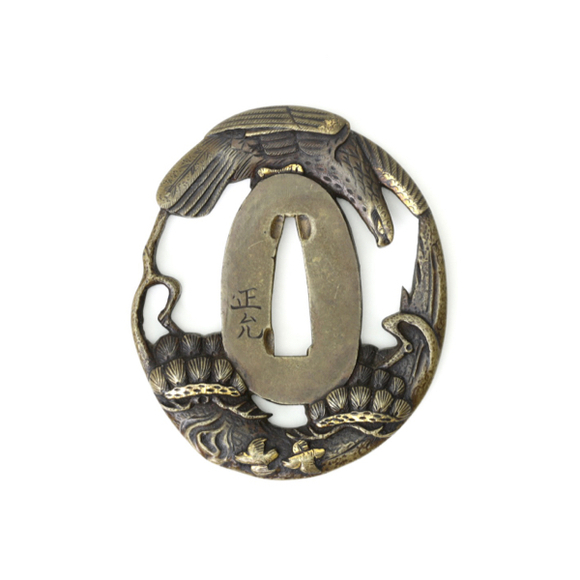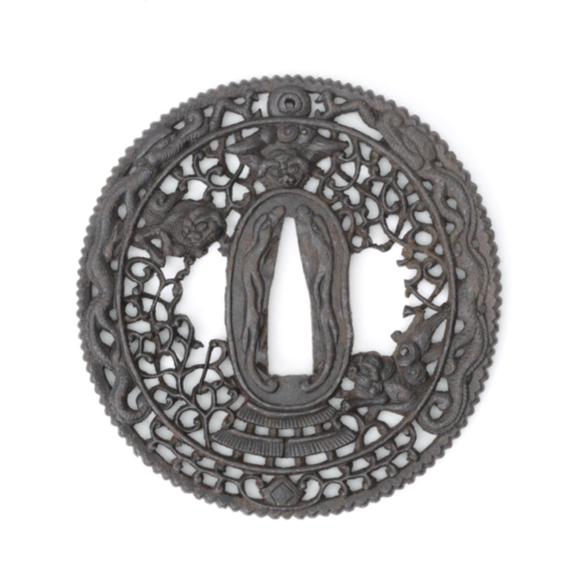Russet iron, one-piece construction with decorative grooves.

72 x 67 x 10 mm
133 grams
Iron, gold
Kinai (記内)
Echizen, Japan
Late 17th - early 18th century
Introduction
The Kinai group started with Kinai Ishikawa (記内石川, ?-1681). He was originally a token kirimonoshi, a carver of horimono (彫刻); engravings on sword blades.
He was originally from Kyoto where he was a student of the Kyoto Shōami school. He then moved to Ōmi province to work for the Maeda Daimyo. Either he or the second generation of his line then settled in Fukui in Echizen province to work for the Sakai Daimyo, and some makers later in the line, which lasted for 8 generations, finally moved to Edo to work for the Sakai residence there.
There are among others blades by masters like Echizen Yasutsugu and Sadakuni with signatures stating that their horimono were by the 1st generation Kinai.2
"His family is known by the name Takahashi, although Sōkenkishō, the standard work on sword ornaments, calls it Ishikawa. About the early part of the 17th century the first Kinai is said to have been selected to carve the sword blades of nanban steel, which Yasutsugu, a famous sword-smith, forged for the Shogun. He was not only an expert with the chisel in embellishing sword blades, but also a tsuba maker. The iron of which his tsuba were made was of the finest quality, and its surface had a smooth polish. He took pride in simple vigorous effects, never using inlay, sometimes working with nanban iron. He was best in perforated work, using as his favorite designs, dragons, storks, bamboo, shells, etc."
-Okabe Kakuya, 1908
Notes to introduction
1. Robert E. Haynes; The Index of Japanese Sword Fittings and Associated Artists A-K. Nihon Art Publishers, 2001. Page 658. Entry H 03169.0.
2. Various authors; Nihon To Koza (Lectures on Japanese swords). Volume 6. Translation by Harry Afu Watson.
3. Okabe Kakuya; Japanese sword guards. Boston Museum of Fine Arts. 1908. Page 49.
This example
Unsigned, made of forged iron, then chiseled to shape. It shows a dragon curling around the seppa-dai, leaving just enough space for one hitsu-ana, the opening for a by-knife or pin often carried in the scabbard of Japanese swords.
The dragon is boldly executed, each element chiseled in high relief. There is considerable precision in the execution of the scales on the dragon's body, which subtly vary in size depending on their placement on the body.
Comparable examples
There are several examples of Kinai tsuba with a similar design in notable museums. Among others:
British Museum, accession number TS.102.
Signed: Echizen ju Kinai Saku (越前住記内作), "Made by Kunai, resident of Echizen".
Ashmolean, Oxford, accession number EAX.10459. (Ex Church collection).
Signed: Echizen ju Kinai Saku (越前住記内作), "Made by Kunai, resident of Echizen".
Ashmolean, Oxford, accession number EAX.10460. (Ex Church collection).
Unsigned.
Boston Museum of Fine Arts, accession number 11.11820. (Ex Bigelow collection).
Signed: Echizen ju Kinai Saku (越前住記内作), "Made by Kunai, resident of Echizen".
Metropolitan Museum, accession number 46.122.105.
Signed: Echizen ju Kinai Saku (越前住記内作), "Made by Kunai, resident of Echizen".
Conclusion
While unsigned, this is an unusually fine and strong piece with clean cuts and deep relief. In style and execution, it is the best example I could in both my many reference books and museum databases.
Many of the signed pieces appear to be watered-down versions of this design, less three-dimensional, less sharply cut, which makes me wonder whether this example perhaps predates most of them.
If you like Kinai work, look no further. This is your tsuba. ;)






Unusual tsuba with foreign figures and Chinese auspicious symbols.






